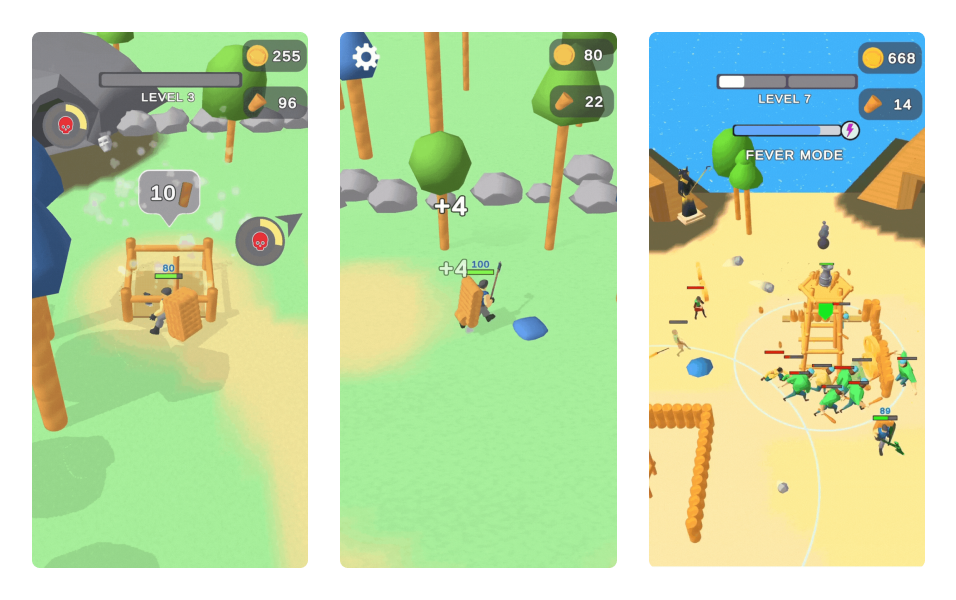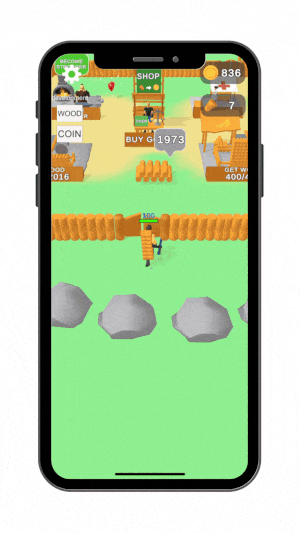· 6 min read
How Noor Games reached a D1 Retention of 62% with the Game Lumbercraft

Beth Jones
Copywriter at Voodoo
Editor’s note: This article was originally published by Voodoo. You read the original version here.
Lumbercraft, the hit game by the studio Noor Games, is not a typical hyper-casual game. With a successful fusion of a core hyper-casual game mechanic and more casual objectives, Lumbercraft is a great example of innovating in the hyper-casual sphere and exploring the possibilities when thinking of the up-and-coming hybrid-casual space. Let’s take a look at the studio behind the game, the game mechanics, and some key takeaways from the development process.
Noor Games are a 5-person studio from Armenia and have been working with Voodoo for over a year, regularly tuning in to our live streams and keeping up to date with our resources for studios looking to create hit hyper-casual games. Thanks to their hard work and commitment in the hyper-casual sphere, their prototypes have improved throughout the year and in October 2020, they started prototyping an interesting new take on the woodcutting trend. The game, Lumbercraft, first appeared for testing in November and was officially launched in January 2021. Despite having a slightly longer prototype phase due to the more casual nature of the game, Noor Games managed to stay on the ball and keep the hyper-casual mindset of testing and developing in super-quick sprints.

Game mechanics
In this game, you play as a lumberjack. The central focus of the game is crafting. Your goal is to chop down and collect enough wood to craft your village; making buildings, shops, as well as battlements to protect it. Each level has an optional mini-battle where you can prove your acquired crafting skills to fight off enemies. The only control is the ‘drag to move’ mechanic which allows you to direct your character around the space. All other actions are automatic. When you stand next to a tree, you’ll automatically chop it down, when you stand next to building squares, you’ll be given the option to build. So it’s up to you to choose how much wood you want to collect, what to build, and whether or not you want to go and fight.

The simplicity of this game mechanic gives Lumbercraft its hyper-casual grounding. Anyone can pick up the game and understand what they have to do within a few seconds. And yet there are multiple themes within the game: chopping wood, crafting buildings, and fighting. The sense of variety and progression in the game introduces the casual fusion. As your craft and fortify your village, level up your character, and improve your skills, Lumbercraft provides each player with clear objectives, giving them a perspective beyond the usual 30-second sessions that we expect to see in hyper-casual.
Ideation and prototype
Noor Games were originally inspired by the woodcutting trend in hyper-casual, as seen in games such as Magic Woods and Zombs.io. But they wanted to give a fresh perspective on this trend and create a new feeling around this theme. The initial CPI video, which put emphasis on the woodchopping mechanic, performed very highly, hitting a 0.10c CPI, so the team started working on their first iteration. This again showed very promising results, so they decided to iterate again, focusing on developing the optional fighting theme by adding different enemies and zones. The results, however, were not as positive as they had hoped. The focus on fighting had such a small impact on the data that they knew they had to either pivot or kill the game. Despite the super low CPI, the teams felt that with a 32% Day 1 retention, there was more to be done to make sure the game was hitting its full potential.
To pivot or not to pivot
After careful reflection and brainstorming with the Voodoo team, Noor decided to shift their focus from the fighting to the crafting aspect. Giada Mazzola, Publishing Manager at Voodoo, states: “‘The first iteration had such a small impact on the data that we questioned whether we were focusing on the right thing. Noor suggested that the chopping and crafting aspect is what really stood out in the original CPI video, so we decided to shake up the core of the game itself, bringing in the idea to create, build, and fortify a village”. So they gave the next iteration a longer sprint, pivoting completely by adding more crafting elements to the game, whilst being careful not to neglect the fighting either. The third version managed to boost the Day 1 retention to a whopping 62%, showing that their pivot had paid off.

The first key takeaway from Lumbercraft’s journey from prototype to launch is knowing when to pivot. “Don’t hesitate to make big pivots to your game if it’s proven to be a super marketable idea”, Giada adds. “Bring in something bigger, add something new, change the feeling of the game. Pivoting can be great but it needs to be big”. After several more iterations, the game was officially launched in January 2021 and has now been passed from our Publishing Team to our Launch and Game OPS teams to keep building and improving the game. They’ve been busy finding new directions and possibilities for Lumbercraft, working in close collaboration with Noor Games, so we can expect more exciting updates to the game coming soon.
Great games with great metrics and a hyper-casual feel
“Publishing with Voodoo was a great experience for us, we had full freedom to create the gameplay that we wanted with good directions from the Publishing Team. They helped us learn how to fail faster and provided a lot of expertise, all whilst showing us a lot of respect throughout the experience.” Narek, Noor Games
The second key takeaway from this experience is to be open to exploring new possibilities and chasing your creativity. Here at Voodoo we’re open to testing and supporting innovative prototypes that don’t necessarily conform to all the requirements of hyper-casual. We’re looking for great games with great metrics and a hyper-casual feel, and Lumbercraft is an excellent example of how open our criteria can be. When a studio shows potential, we’re more than happy to adapt, and it’s exciting to see projects like Lumbercraft take off as a result of this kind of collaboration. A huge congratulations once again to Noor Games. Keep an eye out for more exciting Lumbercraft developments in the near future!
Ready to submit your game and start working with Voodoo? Get in touch here.
Fancy some more reading before your move on? Have a gander through The Voodoo Art Manual, or their top tips to increase efficiency in Hyper-Casual game development.